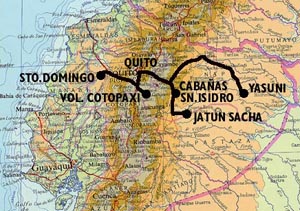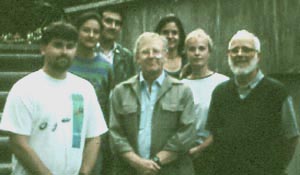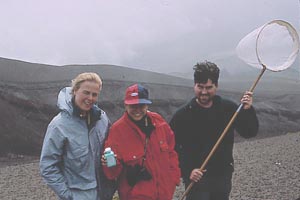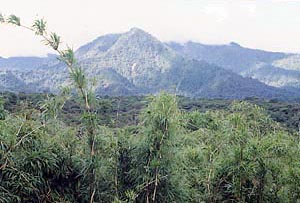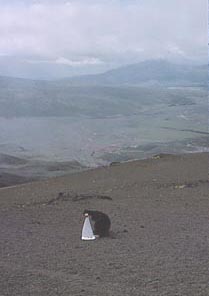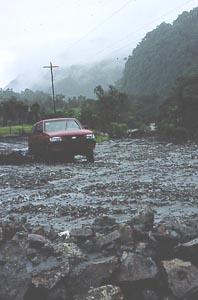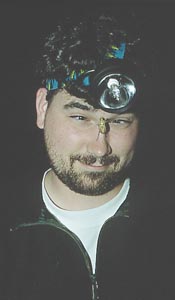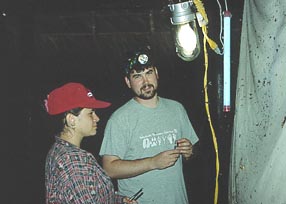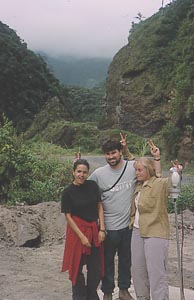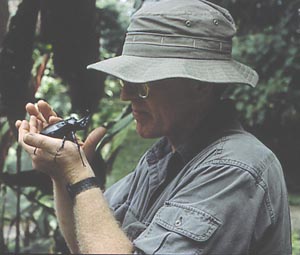|
.
|
Map
of Ecuador showing route and collecting localities for Team Scarab
expedition.
|
. |
|
|
| The
entomology collection at the Catholic University in Quito is
the largest in Ecuador and has substantial holdings of all the
target taxa for our NSF-PEET project. The curator of the collection
is Giovanni Onore who has spent many years building this collection.
He has advised many students who conducted taxonomic studies
of Scarabaeoidea over the years, which has resulted in the collection
containing an extensive representation of the Ecuadorian scarab
fauna. Aura Paucar, one of Dr. Onore's current students, was
just finishing her thesis on the Rutelinae of Ecuador. Another
student, Carlos Carpio, was conducting research on the Scarabaeinae
(dung beetles) of Ecuador. |
| . |
|
. |
Scarab
workers at the Catholic University of Ecuador.
From left to
right: Andrew Smith, Aura Paucar, Carlos Carpio,
Brett Ratcliffe,
Karla Villatoro, Mary Liz Jameson, and, Giovanni Onore.
|
. |
|
|
| ____________________________________________________________________________________ |
| |
|
|
| The first collecting stop was at Cotopaxi
National Park, which is about three hours south of Quito. Volcán
Cotopaxi (which is the highest active volcano in the world at 5,897
m) was a unique collecting locality because of its elevation. During
the day we collected as high as 4,500 m on Volcán Cotopaxi
where the ground consisted of volcanic rock and gravel and an occasional
sparsely distributed flower. Even in these extreme conditions,
two species of tachinid flies were collected. |
|
|
|
|
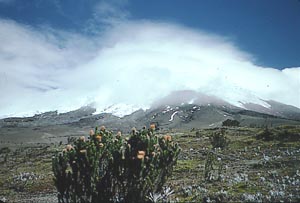 |
Mary Liz Jameson, Karla Villatoro, and Andrew Smith collecting
in moonscape-like conditions on Volcán Cotopaxi at 4,500
m!
Photo by Brett Ratcliffe.
|
|
View of Cotopaxi, the highest active volcano in the world.
Photo
by Karla Villatoro.
.
|
. |
|
|
|
|
|
Tropical wet forest at Cabañas
San Isidro
at 2,150 m.
Photo by Andrew Smith.
|
|
Andrew Smith collecting tachinid flies on
Volcán Cotopaxi.
Photo
by Brett Ratcliffe.
|
. |
|
. |
____________________________________________________________________________________
|
| . |
|
|
After collecting at high
elevation, Team Scarab descended the eastern slopes of the
Andes to investigate mid-elevational habitats at around 2,000
m. The mountain roads were fairly good except for the occasional
sections which had been washed out by landslides. One part
of the road between Baeza and Cosanga was so badly washed out
that no one had been able to cross it. After surveying the
damage, we decided that the lure of good collecting outweighed
the fear of getting hopelessly stuck in the mud. So, after
a careful assessment of the best route to take, we crossed
the wash-out to the cheers and amazement of dozens of local
spectators. We were elated after overcoming that obstacle.
. . but the celebration was short-lived as we rounded a curve
on the road and beheld an insurmountable landslide totally
blocking the road. Luckily, this obstacle was only a short
distance from our final destination, and we were able to transport
our equipment over the mud and derbis and proceed to Cabañas
San Isidro. San Isidro is situate on top of a hill surrounded
by largely intact tropical wet forest. Persistence paid off as
this was an excellent collecting locality. |
| . |
|
|
|
|
|
Traversing a landslide
near Cabañas
San Isidro. |
|
"Here is looking at you, bug!"
Andrew
Smith with Ancognatha vulgaris .
Photo by Mary Liz Jameson. |
| . |
|
|
| The protocol for collecting at each locality typically
consisted of seeking out suitable trapping sites followed by setting
fruit and dung baited traps and flight intercept traps. During
the day, vegetation, fungi, and dead logs were gleaned. Light traps
were set up before dusk and tended continually while they were
operating, and during this time foliage gleaning and general collecting
were also conducted. Specimens were temporarily curated for transportation
back to the lab. |
| . |
|
|
|
Karla Villatoro
and Andrew Smith collecting at light traps at Cabañas
San Isidro.
Photo by Brett Ratcliffe. |
| . |
|
|
| ____________________________________________________________________________________ |
| . |
|
|
| Team Scarab then descended further in elevation to
the Amazon lowlands. Two localities along the Río Napo were
targeted for collecting: Jatun Sacha (450 m) and Yasuni (215 m).
The Río Napo is the largest river in Ecuador and a major
tributary of the Amazon River. The first stop in the lowlands was
at Jatun Sacha Biological Station. Jatun Sacha is a well known
location among scientists because it has been a protected area
for at least a decade. After a couple of days at Jatun Sacha, Team
Scarb went to Yasuni National Park further down the Río
Napo. Yasuni is the largest national park in Ecuador. It was established
to conserve a wide variety of different lowland tropical forest
habitats and as a reserve for the Huaorani people. The fact that
Yasuni is an indigenous reserve, coupled with the extensive oil
drilling there, requires that access to the area is very restricted.
Team Scarab was required to have advanced permission from the Catholic
University in Quito as well as from the oil company and surrender
their passports before they could enter Yasuni. All the trouble
was worth it because Yasuni contains some of the most extensive
and fantastic tropical rain forests we have seen. We stayed at
a field station in Yasuni operated by the Catholic University in
Quito. |
| . |
|
|
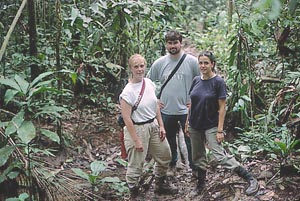 |
|
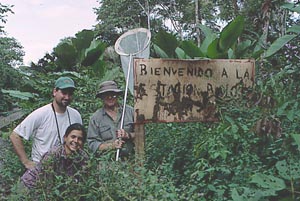 |
Mary Liz Jameson, Andrew Smith, and Karla Villatoro
day-collecting in the lowland rainforests at Yasuni National
Park.
Photo by Brett Ratcliffe.
|
|
"Bienvenidos to WHAT?"
Andrew Smith,
Brett Ratcliffe and Karla Villatoro at Estación
Científica Jatun Sacha.
Photo by Mary Liz Jameson.
|
.
|
|
|
| ____________________________________________________________________________________ |
| . |
|
|
| Our last collecting location was on the western slope
of the Andes around Santo Domingo. We thoroughly enjoyed our expedition
to Ecuador and returned with many specimens that will be invaluable
in our research on Neotropical scarab beetles. |
| . |
|
|
|
|
|
Karla Villatoro, Andrew Smith,
and Mary Liz Jameson with antennae extended near
Santo Domingo.
Photo
by Brett Ratcliffe. |
|
"You, me, and a #7 pin".
Brett
Ratcliffe with Megasoma actaeon at
Estación Jatun
Sacha.
Photo by Andrew Smith. |
| . |
|
|
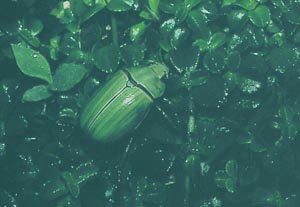 |
|
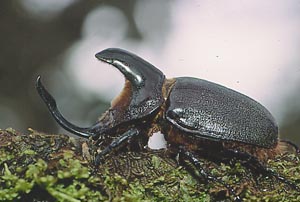 |
Pelidnota
prasina at Estación
Jatun Sacha.
Photo by Mary Liz Jameson. |
|
Heterogomphus
schoenherri at
Cabañas San Isidro.
Photo by Brett Ratcliffe. |
| . |



